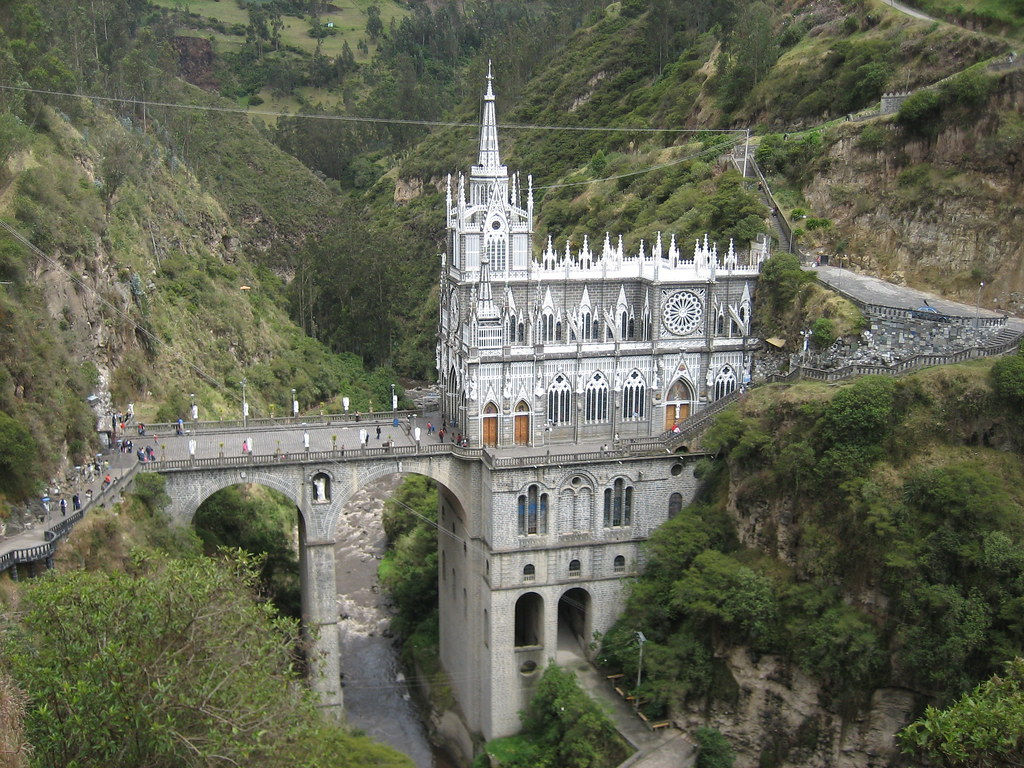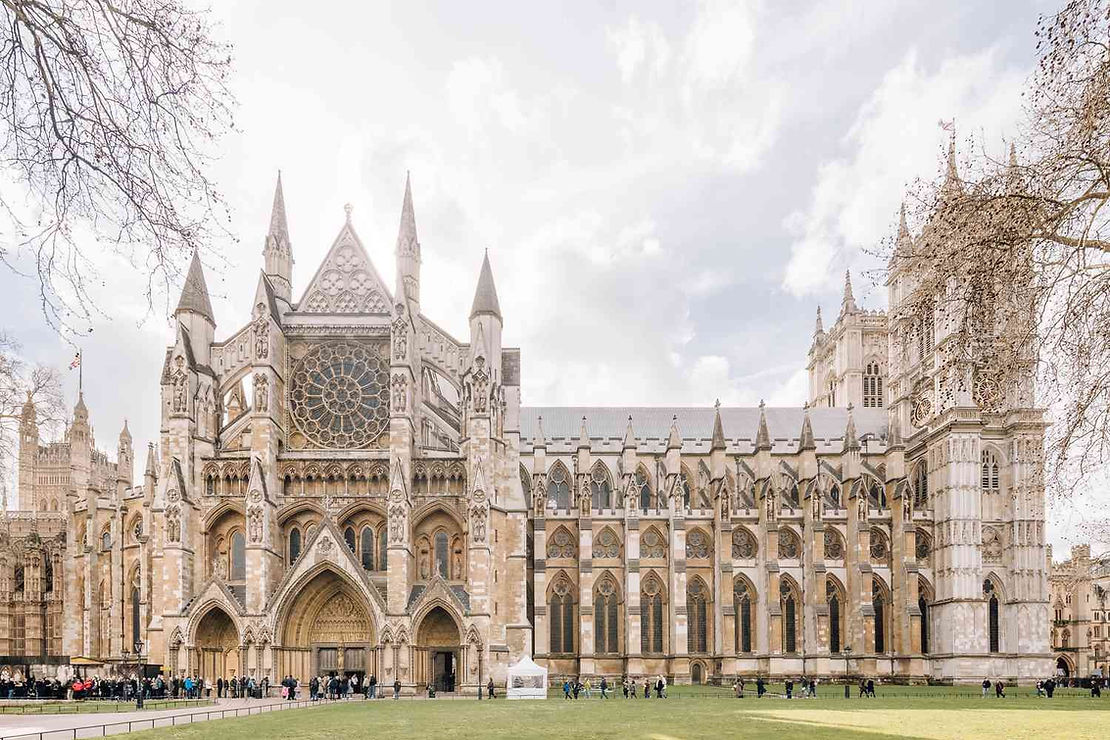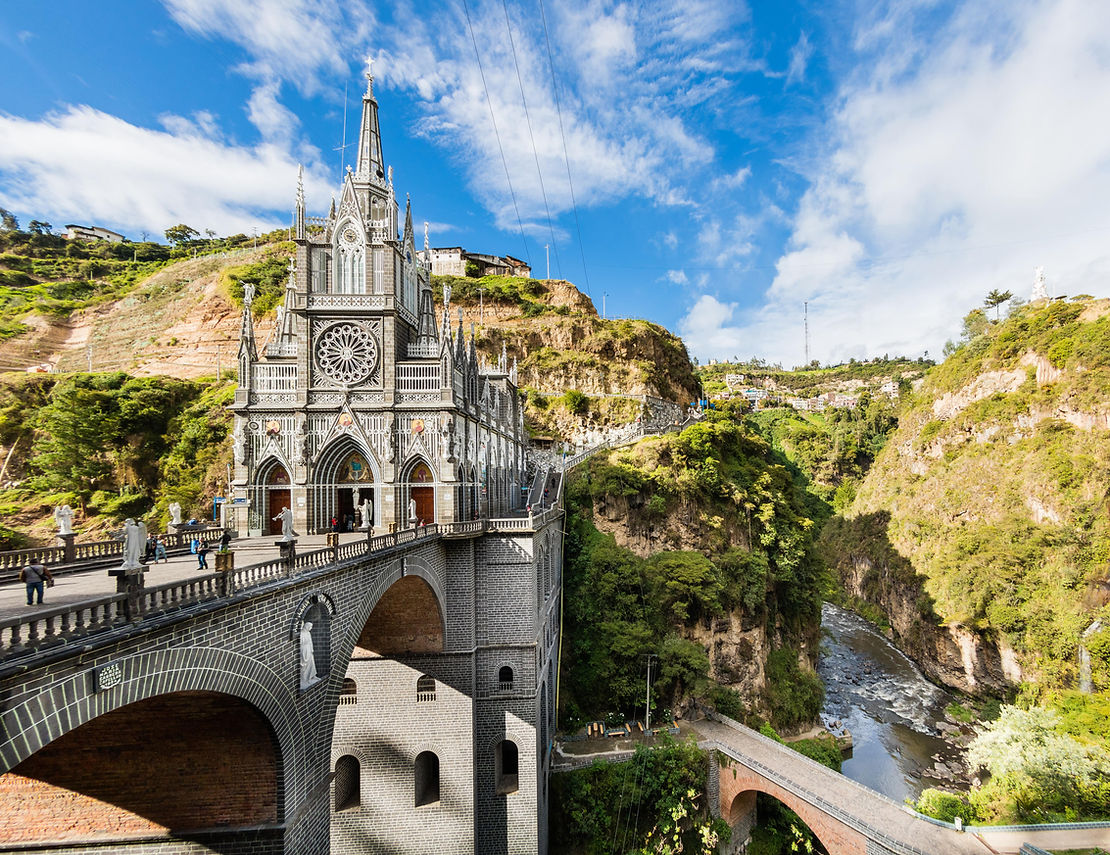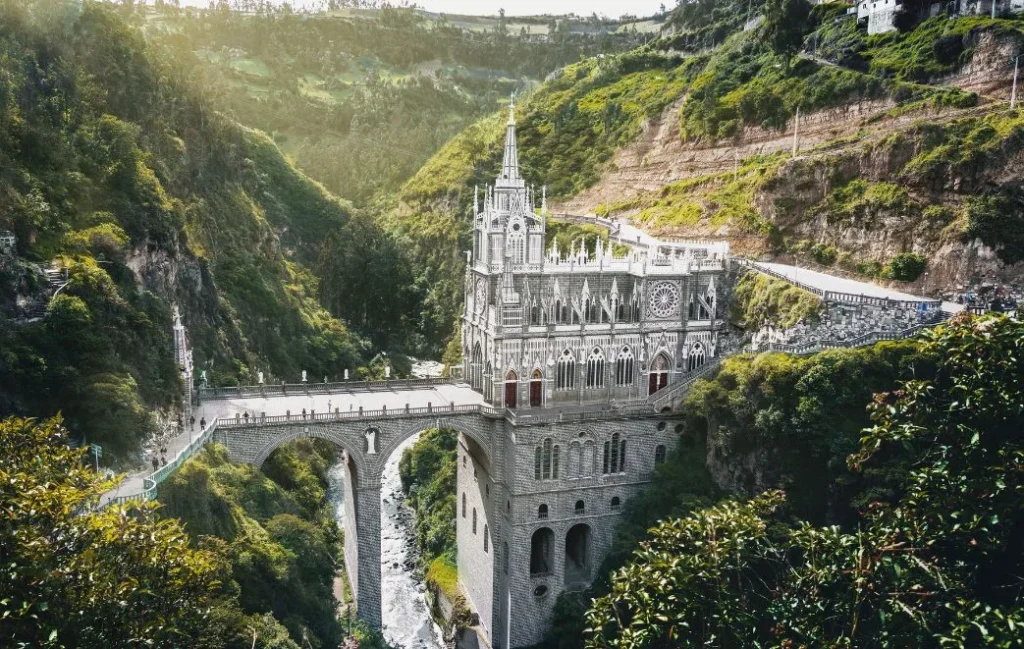Nestled in the canyon of the Guáitara River in southern Colombia, Las Lajas Sanctuary stands as an architectural marvel and a testament to human ingenuity. This breathtaking basilica, built between 1916 and 1949, attracts visitors worldwide, drawn to its unique design and the mystical legends that surround it. The sanctuary, dedicated to the Virgin Mary, showcases some of the finest examples of Gothic Revival architecture, blending seamlessly with the dramatic natural landscape.
Historical Background of Las Lajas Sanctuary

Origins of Las Lajas Sanctuary
The origins of Las Lajas Sanctuary date back to the 18th century. According to local legend, the sanctuary was established after an indigenous woman, María Mueces, and her deaf-mute daughter, Rosa, experienced a miraculous apparition of the Virgin Mary in a cave. This event, which reportedly restored Rosa’s speech and hearing, led to the construction of a modest chapel, which later evolved into the grand Las Lajas Sanctuary we see today. This humble beginning laid the foundation for what would become one of Colombia’s most revered religious sites.
Legends and Miracles Associated with Las Lajas Sanctuary
Las Lajas Sanctuary is steeped in legends and miracles, further enhancing its mystical allure. Stories of miraculous healings and divine interventions have been passed down through generations, drawing countless pilgrims seeking solace and blessings. One of the most famous miracles attributed to Las Lajas Sanctuary is the healing of María Mueces’s daughter, which is commemorated by a striking fresco on the canyon wall where the apparition occurred. These tales contribute significantly to the sanctuary’s spiritual and cultural heritage, making it a beacon of faith for many.
Architectural Style and Features of Las Lajas Sanctuary

Gothic Revival Elements in Las Lajas Sanctuary
Las Lajas Sanctuary is a prime example of Gothic Revival architecture, a style that emerged in the 19th century and sought to revive medieval Gothic design. The sanctuary’s architectural style is characterized by pointed arches, ribbed vaults, and flying buttresses. These Gothic Revival elements are evident in the intricate stone carvings and the soaring spires that define the sanctuary’s exterior. The dramatic, vertical lines and detailed ornamentation of Las Lajas Sanctuary create a sense of awe and reverence, drawing visitors’ eyes upwards and inspiring contemplation.
Structural Design and Materials Used in Las Lajas Sanctuary
The structural design of Las Lajas Sanctuary is remarkable for its seamless integration with the natural landscape of the Guáitara River canyon. The sanctuary is built into the canyon walls, with a bridge that spans the river and connects the two sides of the gorge. This ingenious design not only highlights the sanctuary’s architectural beauty but also emphasizes its connection to the surrounding environment. The use of local stone and concrete in its construction ensures the building’s durability and stability, while also harmonizing with the rugged cliffs and lush greenery of the canyon.
Interior and Exterior Details of Las Lajas Sanctuary
The interior of Las Lajas Sanctuary is as impressive as its exterior. Inside, visitors are greeted by a high vaulted ceiling adorned with elaborate frescoes depicting biblical scenes and the miracles of the Virgin Mary. The main altar is a focal point, with intricate carvings and a statue of the Virgin Mary that is said to be the same image that appeared to María Mueces and her daughter. The stained glass windows, which filter the sunlight into a kaleidoscope of colors, add to the ethereal atmosphere. On the exterior, the sanctuary’s façade is decorated with detailed stonework and statues of saints, creating a visual feast for visitors.
Design and Construction of Las Lajas Sanctuary

Architects and Builders of Las Lajas Sanctuary
The design and construction of Las Lajas Sanctuary involved the collaboration of skilled architects and builders dedicated to creating a lasting monument of faith and beauty. The primary architect, Lucindo Espinosa, played a crucial role in conceptualizing the Gothic Revival style that defines the sanctuary. His vision was brought to life by the diligent work of numerous craftsmen and laborers, who meticulously executed the intricate designs and structural plans. The collaboration between these talented individuals ensured that Las Lajas Sanctuary would become an architectural masterpiece.
Construction Timeline of Las Lajas Sanctuary
The construction of Las Lajas Sanctuary spanned several decades, beginning in 1916 and culminating in 1949. This extended timeline reflects the complexity and ambition of the project. The initial phases focused on establishing a strong foundation and integrating the structure with the natural canyon walls. As the construction progressed, attention to detail became paramount, with artisans dedicating countless hours to crafting the ornate stonework, stained glass windows, and intricate frescoes that adorn the sanctuary. The completion of Las Lajas Sanctuary marked the fulfillment of a vision that had been many years in the making.
Symbolism in Las Lajas Sanctuary

Religious and Cultural Symbolism in Las Lajas Sanctuary
Las Lajas Sanctuary is rich in religious and cultural symbolism, which adds to its significance and allure. The Gothic Revival architecture itself is symbolic, representing a revival of medieval Christian values and artistic expression. Each element of the sanctuary, from the soaring spires to the detailed frescoes, is imbued with religious meaning. The central image of the Virgin Mary, which is believed to have miraculously appeared on the rock face, serves as a powerful symbol of faith and divine intervention. This image is the focal point of the sanctuary and a source of inspiration for countless pilgrims.
Artistic Elements and Motifs in Las Lajas Sanctuary
The artistic elements and motifs found throughout Las Lajas Sanctuary further enhance its symbolic richness. The stained glass windows, depicting scenes from the Bible and the lives of saints, are not only visually stunning but also serve to educate and inspire visitors. The detailed stone carvings, which include depictions of angels, saints, and biblical events, add layers of meaning and provide a visual narrative of Christian faith. These artistic details are meticulously crafted to convey religious stories and messages, making Las Lajas Sanctuary not just a place of worship, but also a repository of sacred art and symbolism.
Significant Renovations and Restorations of Las Lajas Sanctuary

Major Renovation Efforts at Las Lajas Sanctuary
Over the years, Las Lajas Sanctuary has undergone several significant renovation efforts to preserve its structural integrity and aesthetic beauty. These renovations have been essential in maintaining the sanctuary’s grandeur and ensuring that it continues to inspire awe in visitors. Efforts have included reinforcing the foundation, repairing weathered stonework, and restoring the intricate frescoes and stained glass windows. These renovations have been carried out with great care to preserve the original design and craftsmanship, ensuring that the sanctuary remains true to its historic and artistic roots.
Preservation of Original Design at Las Lajas Sanctuary
Preserving the original design of Las Lajas Sanctuary has been a priority in all renovation efforts. Restoration specialists have employed traditional techniques and materials to maintain the authenticity of the sanctuary’s Gothic Revival architecture. This commitment to preservation ensures that the sanctuary retains its historical and cultural significance. The careful restoration of artistic elements, such as the frescoes and stained glass windows, has also been a focal point, allowing these intricate works of art to continue to tell their stories for generations to come. Through these efforts, Las Lajas Sanctuary remains a timeless symbol of faith and architectural brilliance.
Comparative Analysis of Las Lajas Sanctuary

Comparison with Other Gothic Revival Churches
Las Lajas Sanctuary stands out among Gothic Revival churches due to its unique location and design. Unlike many Gothic Revival churches that are situated in urban settings, Las Lajas Sanctuary is dramatically perched in a canyon, integrated into the natural landscape. This distinct setting enhances its architectural beauty and adds an element of awe that is unparalleled. When compared to other famous Gothic Revival structures, such as the Cologne Cathedral in Germany or St. Patrick’s Cathedral in New York, Las Lajas Sanctuary’s location and its bridge over the Guáitara River make it uniquely spectacular.
Unique Aspects of Las Lajas Sanctuary
The uniqueness of Las Lajas Sanctuary extends beyond its location. The sanctuary’s integration with the canyon walls and its bridge design are engineering marvels that set it apart. Additionally, the sanctuary’s origin story and the legends of miraculous events give it a spiritual significance that enriches its architectural value. The combination of natural beauty, architectural innovation, and religious significance make Las Lajas Sanctuary a one-of-a-kind destination for both pilgrims and architecture enthusiasts.
Impact on Local Community

Economic and Social Impact of Las Lajas Sanctuary
Las Lajas Sanctuary has a significant economic and social impact on the local community. The influx of visitors and pilgrims provides a steady source of income for local businesses, including hotels, restaurants, and souvenir shops. This economic boost supports local livelihoods and contributes to the development of the region. Moreover, the sanctuary’s prominence as a cultural and religious site fosters a sense of pride and identity among the local population, strengthening community bonds and social cohesion.
Involvement of Local Artisans and Craftsmen at Las Lajas Sanctuary
The construction and ongoing maintenance of Las Lajas Sanctuary have involved the skills of local artisans and craftsmen, who have contributed their expertise to the sanctuary’s intricate designs and restorations. This involvement not only ensures the preservation of traditional techniques and craftsmanship but also provides employment opportunities for skilled workers in the area. The collaboration between the sanctuary and local artisans highlights the importance of community participation in preserving cultural heritage.
Conclusion

Las Lajas Sanctuary is not only a stunning example of Gothic Revival architecture but also a place of profound spiritual and cultural significance. Its unique location, rich history, and intricate design make it a must-visit destination for pilgrims and tourists alike. The sanctuary’s commitment to divine appreciation and community involvement ensures that it remains a cherished landmark for future generations.
Final Thoughts on Las Lajas Sanctuary
In conclusion, Las Lajas Sanctuary stands as a testament to faith, art, and human ingenuity. Its breathtaking architecture and serene setting offer a sanctuary for reflection and inspiration. Whether you are drawn to its religious significance or its architectural beauty, a visit to Las Lajas Sanctuary promises a memorable and enriching experience.

Recent Posts
15 Floor Plan Graphic Styles That Will Elevate Your Presentation Game
The Role of Shadows in Architectural Storytelling
When Furniture Becomes Architecture: Blurring the Line